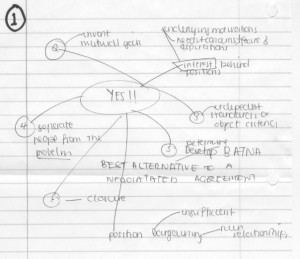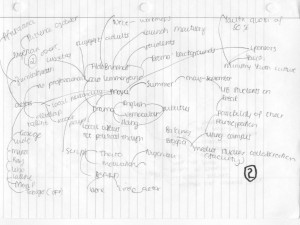An Idea Mapping Success Blogs Weblog
Idea Map #194 – #197 [Reflections of College Students Using Idea Mapping for Study Skills]
23Oct2009 Filed under: Idea Mapping Example, Idea Mapping Workshops, Mind Mapping Examples, Studying for Exams Author: Jamie NastDr. Tim Schweizer is a Professor of Management at Luther College in Decorah, IA. He is also a Certified Trainer: Six Thinking Hats™, Lateral Thinking™ (Edward de Bono tools), and Former Vice President, Altshuller Institute for TRIZ Studies. One of the courses he is currently teaching is Principles of Management. It is required for the Management major and minor, and is usually the first “management” course students take. It is open to students at the sophomore level and above. Luther College is a liberal arts school, so his class is open to non-majors as well as majors.
This is going to be a new series where I’m going to share with you the results and reflections of these college students as they are learning to implement Idea Mapping into their life and studies. Tim was a participant in my Idea Mapping Workshop in August of 2008 and has been teaching students frequently since then. He has also contributed several very popular Idea Mapping Examples himself to this blog. Tim purchased 20 copies of the Idea Mapping Book for the college and his students read the first 5 chapters.
This first reflection is from Thato Masire, and I’ll let him tell you his thoughts in his own words:
“During the first half of the semester, my Management Professor, Tim Schweizer taught us a skill that I could have never imagined learning in college let alone in a Management class. Over a number of class periods Tim had us do some readings on idea mapping and also some in-class exercises.
I can sincerely say that idea/mind mapping is a skill I use regularly across many disciplines and even in my private endeavors. Idea mapping has truly proved to be an indispensable skill to me.
From the idea mapping formula there are some things that do not work for me for various reasons. I have just decided to discard the things that don’t work for me. In my maps I don’t use color, because I feel like changing pens slows down the process of gathering ideas or scribbling down notes. My maps do not only have one word to represent ideas or concepts, but sometimes it is a two or three word phrase so as to remember what I was making note of.
There are a number of things that work for me with idea mapping that outweigh those that do not work. That is why I regularly use idea mapping. What works for me is that idea mapping allows the gathering of ideas quickly, varied and numerous. The fact that they are personalized makes them more meaningful to me. Nobody besides myself has to understand, and I have the liberty to do whatever works for me as an individual. The branches help organize related ideas or information.”
I appreciate Thato for taking the time to share his thoughts, and respect that fact that he can discern when to adapt the idea mapping guidelines to fit his purpose instead of being locked into the rules as the mind mapping laws dictate. His first idea map is for a topic that he was tested on – ” Getting To Yes” – negotiation skills. The second example is an idea map for a movie idea that he would like to implement – Thato noted that the ideas flowed easily here. Examples three and four were idea maps for topics that he was going to be examined on. Thanks Thato!
9 Responses to “Idea Map #194 – #197 [Reflections of College Students Using Idea Mapping for Study Skills]”
Leave a reply
Idea Mapping Blog
The purpose of this blog is to share idea mapping examples and related learning from my Idea Mapping, Memory, Speed Reading, and Certification Workshops. This blog is dedicated to my Certified Idea Mapping Instructors, my clients, Mind Mapping and Idea Mapping practitioners around the globe.




![[Ask]](http://ideamapping.ideamappingsuccess.com/IdeaMappingBlogs/wp-content/plugins/bookmarkify/ask.png)
![[del.icio.us]](http://ideamapping.ideamappingsuccess.com/IdeaMappingBlogs/wp-content/plugins/bookmarkify/delicious.png)
![[Digg]](http://ideamapping.ideamappingsuccess.com/IdeaMappingBlogs/wp-content/plugins/bookmarkify/digg.png)
![[Facebook]](http://ideamapping.ideamappingsuccess.com/IdeaMappingBlogs/wp-content/plugins/bookmarkify/facebook.png)
![[Google]](http://ideamapping.ideamappingsuccess.com/IdeaMappingBlogs/wp-content/plugins/bookmarkify/google.png)
![[MySpace]](http://ideamapping.ideamappingsuccess.com/IdeaMappingBlogs/wp-content/plugins/bookmarkify/myspace.png)
![[Slashdot]](http://ideamapping.ideamappingsuccess.com/IdeaMappingBlogs/wp-content/plugins/bookmarkify/slashdot.png)
![[Sphinn]](http://ideamapping.ideamappingsuccess.com/IdeaMappingBlogs/wp-content/plugins/bookmarkify/sphinn.png)
![[StumbleUpon]](http://ideamapping.ideamappingsuccess.com/IdeaMappingBlogs/wp-content/plugins/bookmarkify/stumbleupon.png)
![[Technorati]](http://ideamapping.ideamappingsuccess.com/IdeaMappingBlogs/wp-content/plugins/bookmarkify/technorati.png)
![[ThisNext]](http://ideamapping.ideamappingsuccess.com/IdeaMappingBlogs/wp-content/plugins/bookmarkify/thisnext.png)
![[Twitter]](http://ideamapping.ideamappingsuccess.com/IdeaMappingBlogs/wp-content/plugins/bookmarkify/twitter.png)
![[Webride]](http://ideamapping.ideamappingsuccess.com/IdeaMappingBlogs/wp-content/plugins/bookmarkify/webride.png)
![[Email]](http://ideamapping.ideamappingsuccess.com/IdeaMappingBlogs/wp-content/plugins/bookmarkify/email.png)
Idea Map #198 – Reflections of College Students Using Idea Mapping for Study Skills | Idea Mapping
October 28th, 2009 at 4:26 pm
[…] is going to be a fascinating experiment this year with students at Luther College in Decorah, Iowa. Last week’s posting first introduced this series. Now let’s put it into […]
Idea Mapping Experiment at Luther College [Part 8] – Idea Maps #208-209 | Idea Mapping
December 14th, 2009 at 2:52 pm
[…] experiment (initiated by Dr. Tim Schweizer) following students at Luther College in Decorah, Iowa. The October 23, 2008 posting first introduced this series and and the October 28, 2009 post puts this experiment in context. […]
Idea Mapping Experiment at Luther College [Part 7] – Idea Maps #206-207 | Idea Mapping
December 14th, 2009 at 2:55 pm
[…] 14th examples in this year’s experiment following students at Luther College in Decorah, Iowa. The October 23, 2008 posting first introduced this series and the October 28, 2009 post puts this experiment in context. Read […]
Idea Mapping Experiment at Luther College [Part 6] – Idea Maps #204-205 | Idea Mapping
December 14th, 2009 at 2:56 pm
[…] 12th examples in this year’s experiment following students at Luther College in Decorah, Iowa. The October 23, 2008 posting first introduced this series and the October 28, 2009 post puts this experiment in context. Read […]
Idea Mapping Experiment at Luther College [Part 5] – Idea Maps #202-203 | Idea Mapping
December 14th, 2009 at 2:58 pm
[…] 10th examples in this year’s experiment following students at Luther College in Decorah, Iowa. The October 23, 2008 posting first introduced this series and the October 28, 2009 post put this experiment in context. Read […]
Idea Mapping Experiment at Luther College Part 9 – Idea Maps 216 – 217 | Idea Mapping
February 16th, 2010 at 1:54 am
[…] experiment (initiated by Dr. Tim Schweizer) following students at Luther College in Decorah, Iowa. The October 23, 2009 posting first introduced this series and and the October 28, 2009 post puts this experiment in context. […]
Luther College Idea Mapping Experiment Part 10 Shares Idea Maps 219 Thru 222 | Idea Mapping
March 11th, 2010 at 3:06 pm
[…] by Dr. Tim Schweizer in the fall of 2009) following students at Luther College in Decorah, Iowa. The October 23, 2009 posting first introduced this series and and the October 28, 2009 post puts this experiment in context. […]
Luther College Idea Mapping Experiment Part 11 Shares Idea Maps 223 Thru 227 | Idea Mapping
March 23rd, 2010 at 11:02 am
[…] Schweizer in the fall of 2009) which is following students at Luther College in Decorah, Iowa. The October 23, 2009 posting first introduced this series and and the October 28, 2009 post puts this experiment in context. […]
Luther College Students are Back to More Idea Mapping. Idea Map #278. | Idea Mapping
March 9th, 2011 at 12:41 pm
[…] very first posting about this experiment with Luther College students was on October 23, 2009. (You can get some background there.) Dr. Tim Schweizer led the experiment. From this date […]